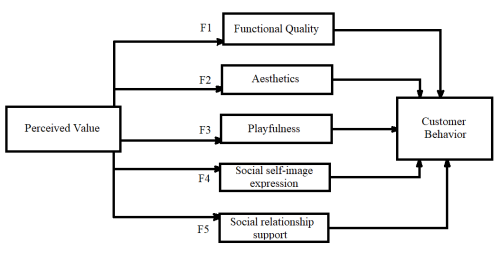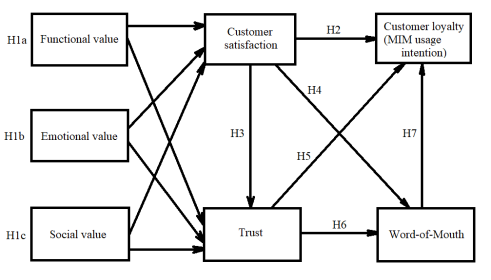At the present time mobile applications are penetrating current market in a large scale. Having a lot of advantages today they are, to say, one of the life’s modern conveniences, so-called “must have” things in our daily routine.
The main purpose of the article is to reveal theoretically the relations between customer engagement, customer perceived value and satisfaction and to test them empirically in the case of mobile applications. Based on literature analysis, relations between customer engagement, perceived value and satisfaction have been revealed. The current study defines three main factors effecting people’s preference and mobile usage intention called customer loyalty regarding mobile applications. Furthermore, the article being based on the scholar theories has a purpose of practical implementation in business and daily adoption.
Keywords: mobile instant messenger, perceived value, customer satisfaction, customer commitment, customer trust, word-of-mouth, customer loyalty
Background
Mobile instant messaging (MIM) being mainly a communication tool is at the same time an instrument of mobile commerce called m-commerce. Several years ago it was doubtlessly new when the Internet had just entered the world. Updating day in day out the Internet is presenting itself as a big platform available to use it anywhere and at any time by the means of mobile phones which every single one possesses today [5,7].
It is obvious that there is a strong need to explore and reveal the main features and reasons for consumers to use Internet in their mobile phones. Moreover, it might be useful for companies in this field to develop their products and services concerning the mobile apps in any area of their lives.
Literature review
Factors influencing usage intention
Perceived value and its’components

Fig. 1. The components of perceived value
«Customer value» is considered to be an important predictor of customer buying behavior. Consumer choice is a function of multiple variables that make different contributions in different choice situations. These value dimensions are comprehensive and form a solid base for further study and extension of existing value factors in marketing and E- and M-commerce. This framework based on findings by Sheth et al. describes functional value as a perceived utility based on digital item’s capacity for functional, utilitarian or physical performance. A product’s functional value emanates from its’ characteristics or attributes such as reliability, durability and price [14].
Functional value is well-known to be treated as a driving factor in using digital items such as mobile applications. Stigler’s economic utility theory assumes this definition and measures it in monetary and functional aspects. Mathwick et al. expressing the importance of functional value refers to key roles of service excellence (functional quality) and customer price utility in user choosing behavior.
Emotional value is also identified as hedonic or experiential value and comprises perceived value from the point of extent of capacity to arouse feelings or emotional states. It derives from specific feelings that a person associates with the product. Hedonic consumption means emotional aspects experienced during its’ usage. In this study emotional side includes aesthetics and playfulness.
Social value describes users’ communication possibilities giving the feeling of current presence of other people not being around at present time. By Sheth et al. social value is described by social self-image expression which means that choosing a digital item, application and other product online defines a customer as a personality and expresses their character and personal values [10].
Interrelation between the factors and hypotheses
Perceived value as described above ha great impact when forming satisfaction and trust [1].
H1. Perceived value has positive effect on customer satisfaction and trust
The hypothesis leads to the next three statements:
H1a. Functional value has positive effect on customer satisfaction and trust
H1b. Emotional value has positive effect on customer satisfaction and trust
H1c. Social value has positive effect on customer satisfaction and trust
Customer satisfaction and customer loyalty (usage intention)
Customer satisfaction is the consequence of the customer's experiences during the buying process (Kotler, 1997a,b) and plays a crucial role in directly affecting customers' future behaviour.
Consumer satisfaction is essential to the longevity of any business and is in fact one of the most researched topics in marketing (Pappu and Quester, 2006). It is defined as the overall evaluation of a consumer’s total purchasing and consumption experience with products or services over a period of time. McDougall and Levesque (1994) showed that customer satisfaction has a positive effect on brand loyalty in several different service sections, such as restaurants and hairdressers. There have been several studies supporting the positive relationship between consumer satisfaction and consumer loyalty [12].
H2. Customer satisfaction has positive effect on MIM usage intention
Loyalty is defined as the degree to which consumers want to purchase products or service from e-vendors in the future. In the world of e-commerce, trust and satisfaction are words that describe the relationship between the business and consumers. When users are satisfied, it will have an impact on retention. To achieve high levels of satisfaction, vendors must understand the formation of relationships and the interactions between consumers and vendors. In addition, Anderson and Narus (1990) found that trust is a stimulant of satisfaction [8]. Customer satisfaction with service plays a critical role in service industries. Satisfied customers tend to be loyal and to spread positive word of mouth.
Nourishing customers' trust in service providers leads to greater satisfaction and loyalty while mistrust leads to lower satisfaction and loyalty. Therefore, long-lasting customer relationships require the establishment and maintenance of trust between customer and service provider [9].
Customer trust
Customer trust is defined as a customer's confidence in a brand's reliability and integrity (Redman et al., 2011). A brand's reliability and integrity are demonstrated through qualities such as being consistent, competent, honest, fair, responsible and helpful (Dholakia, 1997). Attribution theorists suggest that hope is related to the attribution of a positive outcome (a goal) to some external agent (the online retailer) [3]. In the context of online relationships between brands and consumers, the level of positive emotional responses would also be determined by the quality of interaction and communication with the online platforms. If the online retailer is capable of enhancing communication in terms of the quality and relevance of information and responsiveness, then it is more likely that consumers will obtain positive emotions because of their awareness of the benefits they may gain. This results in a higher level of trust in the brand. Customers who experience higher levels of hope toward an online brand should also experience higher levels of trust. Therefore, hope has a positive impact on customer trust in a brand offered by an online retailer.
To sum up, we found out that relations between trust, customer satisfaction, word-of-mouth and MIM usage intention to be as in the upcoming three hypotheses
H3. Customer satisfaction has positive effect on trust
H4. Trust has positive effect on MIM usage intention
H5. Trust has positive effect on word-of-mouth
Word of Mouth
Word of mouth (WOM) refers to any positive or negative statement made by potential, actual, or former customers about a product (Hennig-Thurau,T,2004) [12]. It is especially important for service providers when consumers rely heavily on the advice and suggestions from others who have experienced the service. 10].
When consumers cannot evaluate the value, capability or risk of providers, word-of-mouth becomes a credible, reliable and cost-effective alternative to acquire subjective evaluation and insightful information from other experienced customers within a short period (Chu S.,Kim,Y,2011) [13]. Hennig-Thurau and Walsh (2003) pointed out that consumers read online comments for fast information about the benefits and shortcomings of a product or service to save decision-making time and provoke better buying decisions [14]. Weng Marc Lim’ research on Internet advertisement indicated that WOM has positive effect on consumers’ perceived quality. Thus, the impact of word-of-mouth on usage intention is quite obvious:
H6. Word-of-mouth has positive effect on MIM usage intention

Fig. 2.Interrelation between the factors and hypotheses
H1. Perceived value has positive effect on customer satisfaction and trust
H1a. Functional value has positive effect on customer satisfaction and trust
H1b. Emotional value has positive effect on customer satisfaction and trust
H1c. Social value has positive effect on customer satisfaction and trust
H2. Customer satisfaction has positive effect on MIM usage intention
H3. Customer satisfaction has positive effect on trust
H4. Customer satisfaction has positive effect on word-of-mouth
H5. Trust has positive effect on MIM usage intention
H6. Trust has positive effect on word-of-mouth
H7. Word-of-mouth has positive effect on MIM usage intention
The seven factors effecting customer loyalty presented bellow may be described as the items showed in the table.
Table 1
Description of the factors influencing customer loyalty
|
Factor |
Item |
Source |
|
Functional value Emotional value Social value Trust Customer satisfaction Customer loyalty (usage intention) Word-of-mouth |
MIM is reliable. FV1 MIM has good functions. FV2 MIM fulfills my needs well. FV3 MIM is well provided (messaging, callings, online purchase, ordering things online, etc. FV4 I feel good when I use MIM. EV1 Using MIM is enjoyable. EV2 MIM gives me pleasure. EV3 Using MIM is interesting. EV4 MIM helps me to feel that people like me and want to communicate with me SV1 MIM makes a good impression on other people. SV2 MIM gives me a sense of belonging to other people. SV3 MIM improves the way people perceive me through my photos, personal page, etc. SV4 Based on my experience, I know this MIM service provider is honest. TR1 Based on my experience, I know this MIM service provider cares about customers. TR2 Based on my experience, I know this mobile instant message service provider is trustworthy. TR3 My choice to this MIM service is a wise one. CS1 I think I did the right thing when I subscribed to this MIM service. CS2 Overall, my feeling to this MIM service is satisfactory. CS3 I will continue to use this MIM. CL1 Unpleasant statements about the app would not impact my attitude. CL2 Even if close friends recommended another MIM service, my preference for this MIM would not change. CL3 I would encourage my friends to visit the online forum via the Internet WOM1 I would say positive things about this online forum to other people via the Internet WOM2 I would recommend this online forum to those people who seek my advice via the Internet WOM3 |
Sweeny and Soutar, 2001 Gefen et al, 2003 Croinet et al, 2000 Lin and Wang, 2006 Yahoo e-auction |
Conclusion
It goes without saying that mobile applications are very convenient in terms of saving time and money enabling users to communicate all over the globe no matter how much distant their peers are at the moment [6].
Reviewing the given above material on MIM usage there are now obviously several basic directions and relationships between the factors having impact on customer loyalty. First, as was mentioned all three values — functional, emotional and social — have positive effect on customer satisfaction as well as on customer trust. Secondly, the stronger customer satisfaction is the stronger the customer trust, word-of-mouth and the customer loyalty. Thirdly, trust and positive word-of-mouth leads to high level of MIM usage intention. Therefore, there is an evidence of indirect influence of perceived value consisting of functional, emotional and social and the direct impact of the three core factors as customer satisfaction, trust and word-of-mouth on users loyalty over the MIM preference.
References:
- D. A. Adams, R. R. Nelson and P. A. Todd, “Perceived usefulness, ease of use and usage of information technology: A replication, “MIS Quart, vol.16, no.2, 1992. pp.227–248
- S. L. Jarvenpaa and P. A. Todd, “Consumer reactions to electronic shopping on the world wide web”, Int. J. Electron.Commerce, vol.1, no.2, 1999. Pp.1–35,
- M. Koufaris, “Applying the technology acceptance model and flow theory to online consumer behavior”, Inform.Syst.Res., vol.13, no.2, 2002. pp.205–223,
- G. Torkzadeh and G. Dhillon, “Measuring factors that influence the success of internet commerce”, Inform.Syst.Res., vol.13, no.2, 2002. pp.187–204
- Thakur N.Forensic analysis of WhatsApp on Android smartphones, Master’s thesis, University of New Orleans; 2013, Paper 1706
- Fontaine, R. & Richardson, S. Cultural values in Malaysia: Chinese, Malays and Indians vompared. Cross Cultural Management, 12(4), 2005. pp. 63–77.
- Wang, Y. Sun, S. Lei, W., & Toncar, M. Examining Beliefs and Attitudes toward Online Advertising among Chinese Consumers. Direct Marketing: An International Journal, 3(1), 2009. pp.52–66
- Porter, C. E., & Donthu, N. Using the technology acceptance model to explain how attitudes determine Internet usage: The role of perceived access barriers and demographics. Journal of Business Research, 59, 2006. pp.999–1007.
- Wang, W., J. P. A.,& Song B. Understanding user satisfaction with instant messaging: An empirical study. International journal of Human-Computer Interaction, 28930, 2012. Pp. 153–162.
- Mishra, S., & Novakowski. D. Personal relative deprivation and risk: An examination of individual differences in personality, attitudes and behavioral outcomes. Personality And Individual Differences, 90, 2016. pp. 22–26.
- Wu Z., & Tang, M. Research on WeChat functional service based on the user behavior. Commercial Research, 7, 2014. pp.160–165.
- Jianhua Xu, Qi Kang, Zhiqiang Song, Christopher Peter Clarke, Applications of Mobile Social Media: WeChat Among Academic Libraries in China, The Journal of Academic Librarianship 41(2015), pp. 21–30
- Che-Hui Lien, Yang Cao, Xing Zhou, Service quality, satisfaction, stickness, and usage intentions: An exploratory evaluation in the context of WeChat services, Computers in Human Behavior 68, 2017. pp. 403–410
- Ying Han, F., Gordon, W., Glennda, S. Guanxi, a two-edged sword! How Australian accounting professionals view the process within a moral framework. Managerial Audit. J.29, 2014. pp. 695–716







